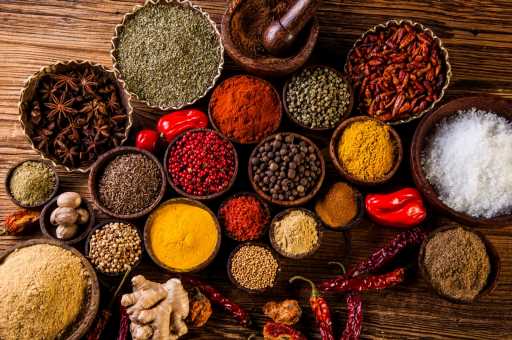I had a hunch that the instructor was correct when he stated that “India produces 50 percent of the global spice trade.” But nonetheless, I checked with my go-to source hereabouts, Zachary Johnston, owner of The Spice Guy in Aurora.
“I would say that number is actually probably low,” he said in a message. “Some India-based companies probably would argue India is closer to producing 75 percent of global spices.”
The percentage may be even higher. According to tradologie.com, an Indian company that tracks wholesale commodity trade in the Middle and Near East, “India contributes 79 percent of global spice production . . . in the year 2020-2021 valued at 19 billion US dollars.”
That’s a lot of freshly ground black pepper.
Perhaps it’s profitable to see how Indian cooking works with its spices (estimated to be 75 out of the 107 whole spices grown globally), pods, roots and seeds such as cardamom and cumin, turmeric and ginger.
The cook quickly learns one thing: There’s no “curry powder” over there. In truth, powders or ground spices are less the rule in the Indian kitchen than their whole (unground) forebears. Indian cooks regularly use whole spices in their recipes (for example, the rice pilaf recipe given here) or hand-grind their own powders after first tricking out all possible flavors and aromas from their whole spices, something we Westerners rarely do with any whole spice.
If we consider such flavor-coaxing too much a bother, it helps to put into perspective that, by and large, the Indian home cook also holds down a job, has kids and otherwise does daily chores—just as the American home cook does. So, it might be a good idea to learn what all the fuss is about.
Simply understood, a mere toasting of a whole spice, in a dry pan or a modicum of some sort of fat, releases and enlivens its dormant essential oils or flavor (and especially aroma) compounds. Some Indian recipes even recommend toasting pulses or lentils before bringing them to more life with a liquid.
Only then, to the grinding.
Simple Rice Pilaf with Whole Spices
Makes 4-6 servings. Serve this with anything, by itself with any form of bread or as a side for any braise, soup or grilled protein.
Ingredients
- 1 1/2 cups basmati rice
- 3 tablespoons ghee (clarified butter) or neutral vegetable oil
- 1 medium yellow onion, peeled, quartered and sliced
- 1 4-inch stick cinnamon, broken in half (or 2 2-inch sticks)
- 8 green cardamom pods, lightly crushed
- 4 whole cloves
- 2 1/2 cups water
- 1 teaspoon sea or kosher salt
Directions
In a large bowl or fine-meshed sieve, wash the rice in 5-6 changes of water until the water runs clear. Set aside to drain.
In a heavy-bottomed pot with a lid, over medium-high heat, melt or warm the ghee or oil until just shimmering. Add the onions, stirring quickly and cook them until they lose color, 4-5 minutes. Push them aside and add the cinnamon stick(s), cardamom and cloves, stirring them in the hot fat until they release their aroma, about 30-45 seconds.
Add the reserved rice and stir it, coating all the kernels with the fat as best you can. Continue stirring until the rice smells nutty, about 2 minutes. Add the water and salt and bring to a boil. Reduce the heat to low, cover the pot and cook, without raising the lid, for 15 minutes.
Remove from the heat and put the pot aside, again undisturbed, for 10 minutes. Remove the lid and fluff the pilaf with a fork and serve. There is no need to remove any of the spices; but for the cinnamon sticks, diners will eat around or consume them as they choose.
Sambar Masala
“Masala” is the Indian name for a mixture of spices—a combination of powders, or dry-toasted whole spices that are then ground; it even may be a paste. Sambar masala will flavor soups or stews, stir-fries or as a rub for grilled proteins. Or sprinkled on popped corn. Mkes just shy of a cup.
Ingredients
- 1/4 cup dried Thai or cayenne chiles, stems off, seeds removed if possible
- 1/4 cup coriander seeds
- 1 tablespoon cumin seeds
- 1 1/2 teaspoons fenugreek seeds
- 1 1/2 black or yellow mustard seeds
- 1 1/2 teaspoons black peppercorns
- 1/4 cups dried yellow split peas or chana dal
- 2 tablespoons turmeric powder, kept separate
Directions
In a dry skillet, over medium heat, toast all the ingredients except the turmeric powder to release their flavors. Keep the ingredients moving in the pan; some (as with the mustard seeds) may begin to pop.
When everything just begins to slightly brown, remove the skillet from the heat so that the ingredients do not burn and pour them onto a plate to cool.
When cool, grind the ingredients in a spice mill or clean coffee grinder (or use a mortar and pestle, in batches if necessary) to the consistency of freshly ground black pepper. In a bowl, add the turmeric powder and integrate well.
Keeps in a tightly-closed container out of the light for 2-3 weeks.
Reach Bill St John at [email protected]
Source: Read Full Article
